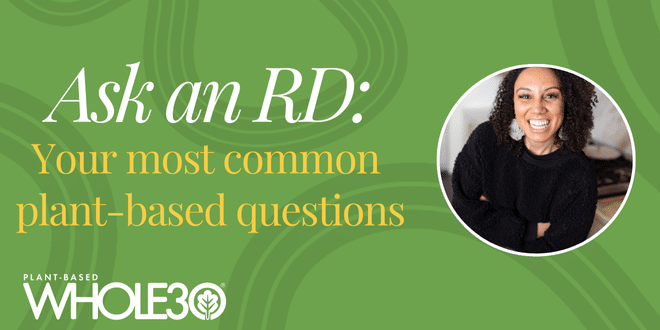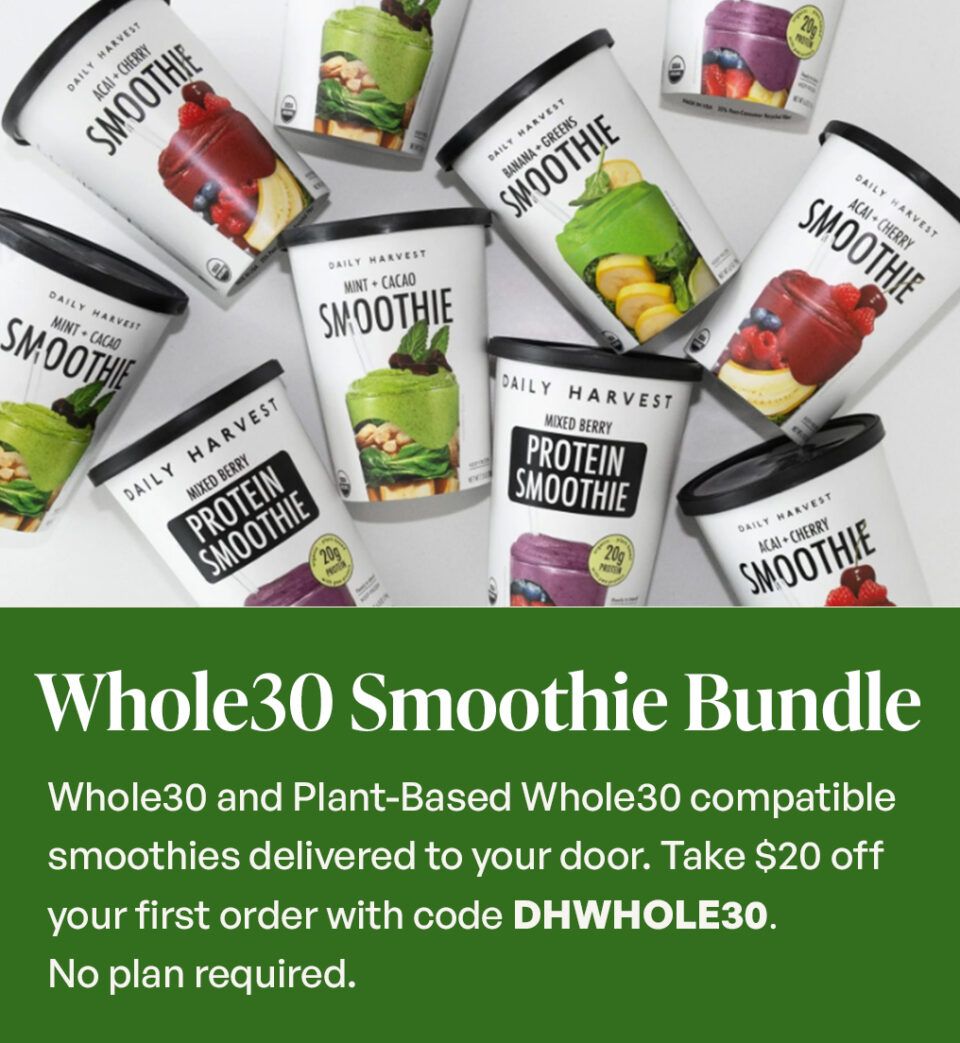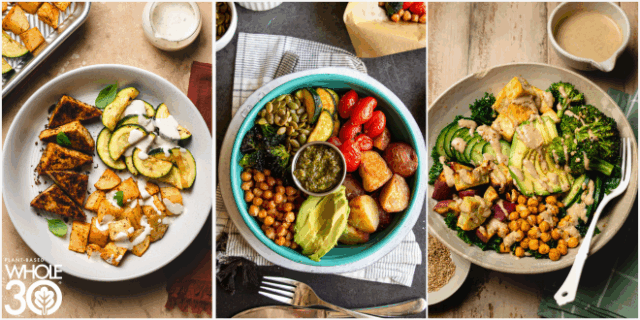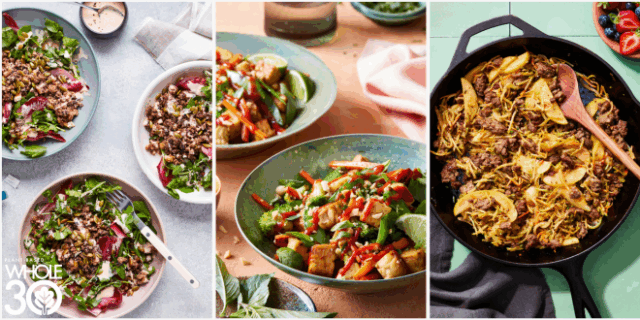Here’s your Ask Me Anything (AMA): plant-based dietitian version. The Plant-Based Whole30 team has taken the most common plant-based questions you have asked and searched for. Today, I’ll answer them from the lens of a plant-based dietitian to help make your Plant-Based Whole30 easier—and help you feel more confident about your choices.
You can also reference our FAQs to answer even more common questions that others in our community have pondered.
What is plant-based eating?
Plant-based eating can encompass any eating pattern that emphasizes foods primarily sourced from plants. In many approaches, this may also include consuming limited amounts of meat, dairy, eggs, and other animal-based products. The Plant-Based Whole30 focuses on finding what foods work for you and excludes all animal products during the elimination phase while leaning heavily on whole, unprocessed plant-based foods. View the program rules here.
Food labels can make it confusing for consumers to know which products to choose. Reading the label is more important than ever to ensure you get what you want at the store. A product might be labeled as “plant-based” but still contain ingredients you prefer to avoid. The ingredients list can inform you of all the components, allowing you to make an informed choice about what you want or don’t want.
How do you start eating plant-based?
Plant-based eating can involve adding one more plant-based meal to your week and building on that. There is no formula for eating more plant-based food; it depends on your preferences, time, and what is realistic for you.
The simplest way to begin is by identifying a plant-based dish you already enjoy and adding it to your weekly meal rotation. You can also discover new recipes on the Whole30 Recipes Page. Oftentimes, we make eating more complicated than it has to be. Start simple and build on it. There’s no “right” or “wrong” way to add more plant-based foods. But if you prefer a step-by-step guide, check out our article “Tips for how to start a plant-based diet.”
How can you eat a more plant-based diet?
Now that you’re starting with eating plant-based, let’s look at how to make your current meals into plant-based meals. Eating more plant-based foods will look different for each person. Instead of feeling like you have to remove items from your meals, try adding more plant-based options. Before you know it, you may have more plant-based items that take over your plate.
A general guideline for starting a plant-based diet is to fill at least half of your plate with a non-starchy vegetable. Adding vegetables to your plate first also helps you eat more vegetables overall.
For inspiration on what a day of plant-based eating can be, here is an example of what I eat in a day during a Plant-Based Whole30 that can help you start eating a more plant-based diet.
What should you eat for breakfast on a plant-based diet?
Breakfast is a great way to start the day. Eating a balanced breakfast starts you on a good path to meeting your nutrient needs. And skipping a full meal in the morning can leave gaps in nutrients that are hard to make up.
Without breakfast, you can start feeling too hungry, leading to overeating or over-snacking later in the day. If you don’t have time or aren’t a big breakfast person, starting with the Plant-Based Whole30 Smoothie is a great way to get into the habit of having breakfast.
Here are some of our other favorite options for a plant-based breakfast:
Where do you get protein when eating plant-based?
As a plant-based dietitian, protein is the number one category I’m asked about. It is possible to meet protein requirements as a plant-based eater. Plenty of plant-based proteins are available, from tofu and tempeh to beans, legumes, and even protein boosters.
These boosters aren’t sole sources of protein, but add 3-5 grams of protein to your meal or snack.
How can you eat a plant-based diet on a budget?
Plant-based foods are among the grocery store’s most affordable and healthy options. The basics to prepare a plant-based meal include a few shelf-stable items and fresh produce, all of which will cost about the same as one package of higher-quality meat.
Specialty and organic items cost more, but aren’t necessary to complete the Plant-Based Whole30. Take a look at these simple tips for eating plant-based Whole30 on a budget for ideas that are easy on your wallet.
Is a plant-based diet healthy?
Yes, when well-rounded. Plant-based eating has been linked to lower rates of heart disease, obesity, and type 2 diabetes. Plant-based foods contain 0 milligrams (mg) of cholesterol and are typically lower in saturated fat, making them heart-healthy options.
Fiber is found solely in plant-based foods, and supports heart health, gut health, and feelings of satiety, which may aid in reducing overeating. Many other fiber-related health benefits can also be observed with a plant-based diet.
What is the downside of a plant-based diet?
Like anything new, plant-based eating can require adjustment. Any diet that isn’t well planned can potentially have gaps. Common nutrient gaps in plant-based eating may include vitamin B12, iron, and calcium.
Many plant-based foods provide essential nutrients, but they can often be overlooked. Iron deficiency is a common one that springs from dietary choices, and may lead to conditions like anemia. However, not everyone with low iron adheres to a plant-based diet, which suggests that nutritional gaps can arise based on the overall composition of anyone’s diet.
To ensure no gaps, a multivitamin is always an option until a well-planned diet is established. Working with a registered dietitian and including plant-based foods high in iron and calcium can help address potential gaps. It is generally recommended for people who don’t consume animal products to take a vitamin B12 supplement. For more information on amounts, consult your primary care physician or a registered dietitian.
What happens to your body when you eat plant-based?
You may experience changes when you start eating more plant-based foods. Some may be beneficial, while others may be a nuisance for a short time. The good news is that they will wear off after a while. Like with the increased gas that comes with higher fiber intake, which improves as your body adjusts to the extra fiber.
Use our “Is This Normal?” guide to see what symptoms are common, but trust your instincts if something feels very wrong or off. You know your body better than anyone, so listen to it and seek care if you need it.
Any more questions? Just ask!
Many questions come up when trying something new, and the best way to find answers is to ask. Don’t hesitate to seek support from us here at the Plant-Based Whole30 with any questions to make your next 30 days a success.
Plant-based eating is an incredibly healthy way to eat, and is also a personal decision. We’re here to guide you in finding the best way to do it for you. Sign up for our Plant-Based Whole30 emails to have support delivered to your inbox weekly.















